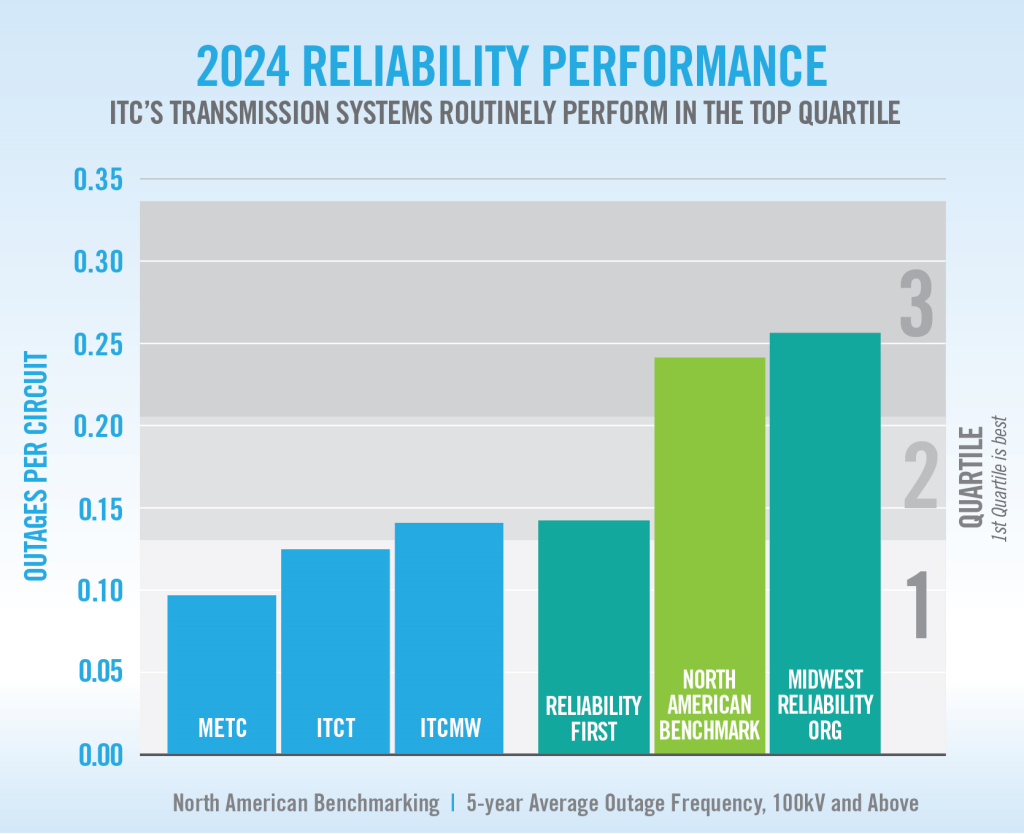
Resilience & Reliability
The Power is On
Whether you flip on a light switch or start a massive assembly line in an automotive factory, our goal is to make sure the electricity is there when you need it.
Reliability is something ITC has taken great pride in over our 20-year history. Likewise, resilience is a key factor in assuring the electricity will be there when you need it. Whether it’s weathering an ice storm or thwarting a cyber attack, ITC is on the job 24/7, 365 days a year.
Reliability
ITC works to make sure our customers steer clear of excessive costs. We ensure that congestion on our lines is kept at a minimum, with the goal of keeping our electric highways open and flowing effectively.
Since its inception in 2003, ITC has steadfastly adhered to its guiding principle of operational excellence to deliver industry-leading reliability performance. A comprehensive analysis of the past decade’s data across ITC Michigan (ITCTransmission and METC) and ITC Midwest demonstrates that our commitment to reliability and resiliency has led to a decrease in outages across all ITC operating companies.
Furthermore, the outstanding performance of ITC’s transmission systems, consistently ranking among the top in North American benchmark surveys, highlights the efficacy of targeted capital and maintenance programs.

Resiliency
The old saying goes “You are only as strong as your weakest link.” It’s ITC’s job to check those links every day, in the form of our intricate design of substations, transmission structures and power lines. We accomplish this in our control center, located in our Novi, Michigan headquarters. Across seven states, we are constantly monitoring and re-routing electricity when needed, with an overall goal of keeping the lights on and our employees safe.
Power Grid Security

The power grid is complex in design and function. This complexity can make it vulnerable to damage from natural events such as severe storms, or malicious actions such as cyber and physical attacks.
Grid security is a big responsibility. To meet the challenge of keeping electricity flowing to our customers, ITC works with partners to help us lessen the risk and safeguard the grid with security and resilience measures.
- Multiple Regional Mutual Assistance Groups (RMAGs)
- Electric Reliability Coordinating Council
- Electricity Subsector Coordinating Council
- State Fusion Centers
- Homeland Security
- State and Federal Regulators
- Our Customers
Wildfire Safety
The safety of our workers, facilities and the public is a top priority. While the risk of wildfire is relatively low across ITC’s footprint, it’s important to remain vigilant and prepared.
Prevention Starts with Risk Awareness
ITC’s extensive risk management process represents an ongoing effort to understand wildfire risks, identify mitigation measures and utilize additional information as it becomes available so that we can respond quickly to potential threats.
To assess wildfire risk, we:
- Use historical and environmental wildfire data to guide long-term planning.
- Account for regional climate, precipitation and fuel types.
- Use forecasts to proactively activate additional mitigation efforts.
- Monitor active wildfires and assess responsive measures.
Mitigation Measures
We implement mitigation measures designed to support the safe and reliable operation of the transmission grid.
- Maintain and Adapt Practices: Continue proven mitigation strategies and adjust as needed to meet evolving conditions, including disabling automated reclosing of lines during high-risk conditions, reducing the likelihood of an ignition.
- Situational Awareness: Utilize environmental and weather system conditions to inform decision making.
- Asset Inspections: Perform additional, proactive infrastructure inspections in high-risk areas to ensure safe operation of the system.
- Vegetation Management:
- Inspect and maintain vegetation clearances.
- Use Integrated Vegetation Management (IVM) strategies.
- Grid Design & Hardening: Upgrade infrastructure to reduce ignition risk and improve resilience.
- Grid Operations: Follow daily operational protocols to reduce wildfire risk.
- Field Practices: Evaluate field activities through a wildfire risk lens.
- Emergency Planning: Collaborate with public agencies for wildfire response and investigation.
